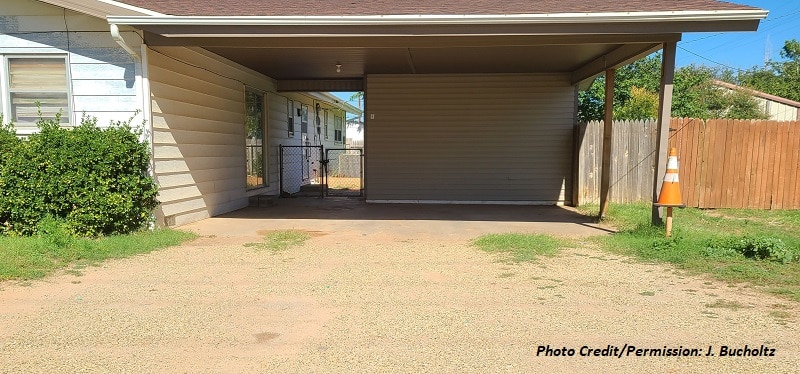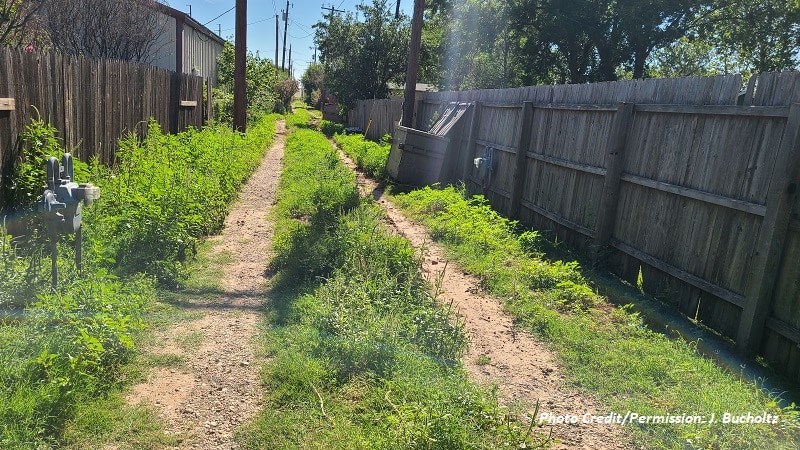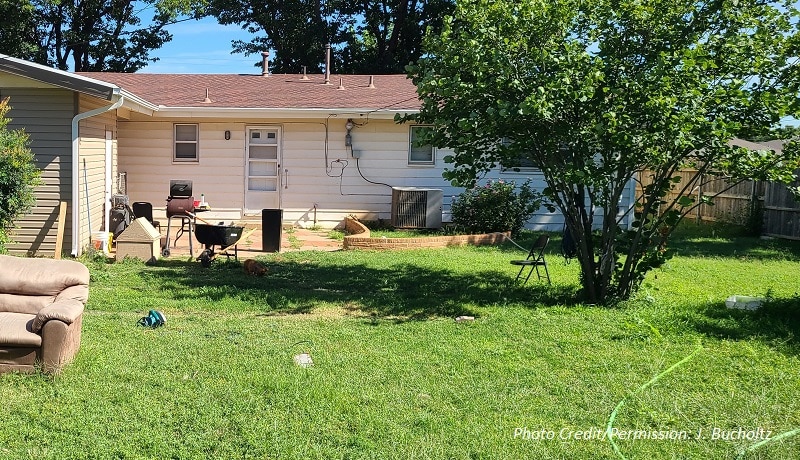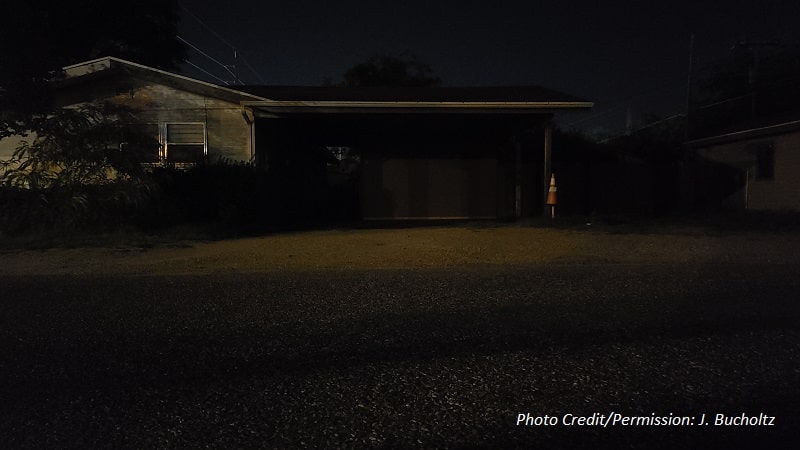By Jennifer Bucholtz
Faculty Member, Criminal Justice and Forensic Science
This is the fifth in a series of articles reviewing and analyzing the facts and evidence related to the murder of Deborah Williamson. Learn about the facts of the case in the first article. Read up on additional information provided by Deborah’s widowed husband in the second article. Learn more about Deborah’s injuries by reading an analysis of her autopsy report in the third article. Follow us as we travel to Lubbock, Texas, to conduct some on-the-ground research in the fourth article.
Deborah “Debbie” Williamson was stabbed to death outside the back door of her home in Lubbock, Texas, on the evening of August 24, 1975. Over 46 years later, no one has been charged and convicted in her murder, and it remains unsolved. Investigative journalist George Jared and I recently accompanied Debbie’s sisters, Liz Flatt and Paula Chasse, to Lubbock to conduct further investigation into the case.
Visiting Debbie’s Crime Scene Proved Invaluable
One of our primary tasks while we were in Lubbock was to visit the location where Debbie was killed. We wanted to view it both during the day and at night, particularly around the time she was murdered.
Arriving at Debbie and Doug’s former home for the first time, during daylight hours, George and I both remarked about the crime scene feeling much smaller than we anticipated. Although the carport is wide enough for two vehicles, it felt cramped (see image 1 below). The distance from the location in the carport where Debbie was attacked to the back step of the home measures approximately 25 feet. In 1975, there was no gate separating the carport from the backyard, as there is now.

Avenue L is the road that borders the west side of the house. It provides vehicle access to the carport, is also narrow and has a negligent amount of traffic.
An unpaved alley runs along the south side of the house and is only wide enough for one vehicle to pass through (see image 2 below).

As we stood in the alley, we could see over the fence and into the backyard (see image 3 below).

Additionally, the gate on that fence swings outward from the yard. We confirmed that the other houses that back up to the alley also have gates that open outward.
Evaluating the Crime Scene at Night
For a nighttime perspective on the crime scene, we arrived at the residence where Debbie was killed on August 24th around 9:20 p.m. and stayed for over an hour. Her murder is estimated to have occurred at approximately 9:30 p.m., so we wanted to view the crime scene and surrounding area on the same date and time as her murder occurred. The current tenant of the home graciously allowed us onto the property and inside the residence.
What struck us immediately was that the carport where Debbie was attacked was incredibly dark, despite ambient lights from the surrounding neighborhood and streets. It was impossible to see into the backyard from the street or carport (see image 4 below).

Currently, there is a light bulb installed in the carport ceiling. At the time of the murder, there was no light fixture in the carport.
In 1975, the houses in the neighborhood were sparse, and there was an empty field across the street. At that time, the area was considered remote, and lighting in the vicinity of Debbie and Doug’s house was minimal.
Even as I stood in the carport for several minutes, letting my eyes adjust to the darkness, I could not discern any of the objects in the backyard or the backyard’s layout. The tenant replicated the reported lighting of the murder scene for us by turning off all lights in the home, except the one over the kitchen sink. This single light provided some illumination of the patio area where Debbie’s body was found, but it was minimal.
We checked the moon phase for the evening Debbie was killed and learned that it was three days past the full moon that night. The moon rose that evening at 9:40 p.m. Even if the moon had crested the horizon at the time of the murder, it still would not have provided any additional illumination because it was too low in the sky.
The Crime Scene Provides Clues about Debbie’s Killer
It is doubtful a stranger who had never been to the home before would have ventured into Debbie’s backyard. Debbie’s husband reported that she would keep the light outside the back door on at night. Even with that light on, someone standing in the street or carport could not have ascertained much information about the backyard’s layout or the location of objects in the yard (such as the patio furniture).
Most likely, Debbie’s killer had been to her house before the night of the murder and knew the backyard’s design. In addition, the killer was probably familiar with Debbie’s habit of exiting the house through the back door, as it provided quicker access to her car than the front door.
This knowledge of Debbie’s habits also means the killer knew that Debbie and her husband did not utilize the sliding glass door that connected their living room to the carport. They had a large china cabinet in front of the sliding door, blocking access to the carport.
Evidence of the killer having prior knowledge of the home was perfectly illustrated when Henry Lee Lucas falsely confessed to Debbie’s murder in 1984. Lucas claimed he entered her house through the sliding glass door in the carport.
A stranger to the home would assume that door was usable and would provide access in and out of the house. Debbie’s killer knew what door she would be exiting from, which means he or she had first-hand knowledge of her home and habits.
Another issue we discovered was that anyone exiting the home would have been “night blind.” This condition occurs when a person transitions from a brightly lit location to a dimly lit one.
While at the residence, I spent several minutes inside the home and then opened the back door to exit. I could not see anything outside the back door because my eyes had not yet adjusted to the darkness.
This temporary inability to see would have been an issue for Debbie as well. If her killer was outside, waiting for her to exit the home, that person would have had a strategic advantage over her as his or her eyes would have already adjusted to the dark.
The majority of the attack against Debbie occurred in her carport next to the driver’s side of her car. Her killer then dragged her body 25 feet to the back step and left her there.
Initially, we thought the killer moved her to delay the discovery of her body. But while we were at the crime scene, we realized the killer actually moved her from a very dark place to the most illuminated location on the property.
What Behavioral Clues Can Be Uncovered about Debbie’s Killer?
My next article will provide some behavioral analysis of the actions Debbie’s killer took during the commission of her murder. There is always a specific reason for every action a killer chooses to engage in during and after a murder. The analysis of these actions can provide clues to the killer’s motive and identity.
Readers who wish to follow the future progress on Debbie’s case are encouraged to join the Facebook group dedicated to getting justice for her, Unsolved Murder of Deborah Sue Williamson (Deborah Agnew). The administrators of the group will continue to post updates and topics for discussion. Anyone who has information about Debbie’s murder is asked to please report tips to the Lubbock Police Department at 806-775-1425 or 806-300-6490.
Read the next article in this series: Behavioral Analysis of Debbie Williamson’s Killer – Part VI

Comments are closed.